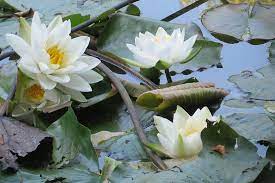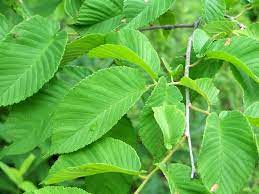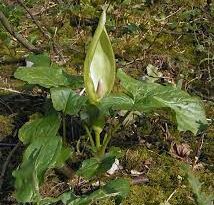9 Medicinal Health Benefits of White Water-lily (Nymphaea Alba)
Nymphaea alba, commonly referred to as the European white water lily, is a water plant renowned for its pristine beauty and healing properties. With its exquisite white blooms floating serenely on the water’s surface, this aquatic wonder has graced the world’s ponds and water bodies for centuries.
Nymphaea alba belongs to the family Nymphaeaceae and the genus Nymphaea. It is a species of the water lily, renowned for its elegance and beauty. This enchanting water lily is native to Europe and can be found in various countries, including France, England, and Germany.
The use of Nymphaea alba in traditional medicine dates back to ancient civilizations, where it was revered for its medicinal properties. Its roots, leaves, and flowers have all been employed for their healing potential.
Nymphaea alba is rich in essential compounds, including alkaloids, flavonoids, and tannins. These bioactive elements contribute to its medicinal prowess.
Nymphaea alba thrives in freshwater environments, gracing ponds, lakes, and slow-moving rivers across Europe and parts of Asia. Its ability to flourish in aquatic habitats contributes to its distinctive beauty.
For those interested in cultivating Nymphaea alba, it is essential to replicate its natural habitat. This includes providing ample sunlight, a stable water temperature, and a nutrient-rich substrate. When cultivated with care, it can flourish in garden ponds, adding a touch of elegance to outdoor spaces.
One of the most distinctive features of Nymphaea alba is its large, circular leaves that float gracefully on the water’s surface. The pristine white flowers, with delicate yellow stamens, rise above the water on long stalks, creating a mesmerizing sight.
Beneath the water’s surface, Nymphaea alba boasts extensive rhizomes, which anchor the plant and absorb nutrients from the water.
Nymphaea alba thrives in calm, freshwater habitats such as ponds, lakes, and slow-moving rivers. It prefers waters with minimal disturbance.
Nymphaea alba reproduces through a fascinating process. Its flowers open during the day to attract pollinators like bees and flies. These insects play a crucial role in transferring pollen from one flower to another, enabling fertilization.
Once pollinated, the flower develops into a fruit that contains seeds. These seeds can be collected and used to propagate new plants, making it possible to cultivate Nymphaea alba in various locations.
Nymphaea alba is not only known for its medicinal qualities but also for its nutritional value. It’s rich in minerals, and antioxidants, vitamins, particularly vitamin C, vitamin B6, potassium, and more. which supports the immune system, and vitamin A, which is essential for eye health, contribute to its diverse health benefits.
Nymphaea Alba is a water plant native to Europe and parts of Asia. This unassuming aquatic plant has garnered attention in recent years for its remarkable health benefits. Used for centuries in traditional medicine, Nymphaea Alba is now being recognized for its potential to alleviate various health issues.
Nymphaea Alba is characterized by its elegant white flowers that float on the surface of still waters. Beneath these pristine blossoms lie its lush green lily pads, creating a picturesque scene in ponds and lakes. But it is not just its aesthetics that make Nymphaea Alba fascinating; it is also its rich nutrient composition.
For centuries, various cultures have revered Nymphaea Alba for its medicinal properties. Ancient Egyptians, for instance, used this plant for its calming and soothing effects. Similarly, Native American tribes incorporated Nymphaea Alba into their healing
In the world of natural remedies, Nymphaea Alba, commonly known as the European white water lily, has been gaining attention for its potential health benefits. This aquatic plant, with its enchanting white blossoms, has a rich history of traditional use and a growing body of scientific research supporting its various medicinal properties.
Nymphaea Alba has a long history of use in traditional medicine. Ancient cultures, including the Egyptians and Greeks, valued it for its medicinal properties. They believed that this water lily held the power to heal various ailments.
Nymphaea Alba, a beautiful aquatic plant with striking white flowers, has been used for centuries in traditional medicine systems worldwide. Its potential health benefits have attracted attention in recent years, but it is crucial to examine both its positive and negative aspects before considering it as a natural remedy.
Nymphaea Alba is a perennial plant that grows in freshwater habitats. Its large white flowers and lily pads make it easily distinguishable. Various parts of the plant, including the roots, leaves, and flowers, have been used for their potential medicinal properties.
Nymphaea Alba has gained attention in the modern wellness industry for several potential benefits. Some of these include its calming effects, potential as a natural sedative, and its role in aiding digestion. Additionally, it’s believed to have antioxidant properties that can support overall health.
Nymphaea alba is a beautiful aquatic plant that has garnered attention for its ornamental value and potential health benefits. However, like any natural remedy, it’s essential to exercise caution when using it.
Nymphaea alba is believed to have several medicinal properties. It is often used in traditional herbal medicine to address issues such as anxiety, sleep disorders, and digestive problems. Additionally, it is claimed to have antioxidant properties, which can help combat oxidative stress in the body.
In the world of aquatic plants, few are as enchanting as Nymphaea alba, the European white water lily. Its pristine white petals and elegant lily pad leaves make it a sought-after addition to water gardens and ponds.
But beyond its aesthetic appeal, Nymphaea alba harbors a wealth of potential health benefits. Throughout history, Nymphaea Alba has been used to address conditions such as anxiety, insomnia, and digestive disorders. Its delicate petals and leaves were steeped into teas and tinctures to harness its healing potential.
The Medicinal Health Benefits of White Water-lily (Nymphaea Alba)

1. Stress and Anxiety Reduction: Nymphaea Alba is known for its calming properties. Consuming it in various forms, such as herbal tea, is believed to reduce stress and anxiety levels, promoting a sense of relaxation.
Nymphaea alba is celebrated for its stress-relieving properties. Its extracts are known to induce a sense of tranquility, making it a natural remedy for anxiety and restlessness.
2. Improved Sleep Quality: For those struggling with sleep disorders, Nymphaea Alba may offer a natural solution. Its sedative properties can help individuals achieve a more restful night’s sleep.
3. Digestive Aid: Digestive discomfort is a common issue that many people face. Whether it is bloating, indigestion, or irritable bowel syndrome (IBS), Nymphaea Alba may offer relief. Its soothing properties can calm an upset stomach, promoting a more comfortable digestive experience.
Nymphaea Alba has been used to alleviate digestive discomfort. It may help soothe stomachaches and improve overall digestive health.
4. Skin Health: Your skin is a reflection of your overall health, and Nymphaea Alba can play a part in enhancing its vitality. When applied topically, Nymphaea Alba extracts can reduce inflammation, promote collagen production, and combat skin conditions like acne.
This natural skincare solution may leave your skin looking and feeling rejuvenated. The extracts of Nymphaea Alba are believed to have antioxidant properties, which can contribute to healthier skin. It may help reduce the signs of aging and promote a youthful complexion.
The application of Nymphaea alba extracts can result in healthier, more radiant skin. Its antioxidants promote skin cell regeneration, reducing the signs of aging.
5. Pain Management: Chronic pain can be debilitating, affecting both physical and mental well-being. Nymphaea Alba’s natural analgesic properties make it a gentle yet effective alternative for pain management. If you’re seeking relief from conditions like arthritis or migraines, it is worth considering Nymphaea Alba.
6. Cognitive Enhancement: In today’s information-driven world, cognitive function is paramount. Nymphaea Alba has shown promise in enhancing memory, focus, and overall mental clarity.
Whether you’re a student looking to boost your academic performance or a professional seeking to sharpen your cognitive skills, Nymphaea Alba may offer support.
7. Cardiovascular Health: Nymphaea Alba’s antioxidant and anti-inflammatory properties may contribute to cardiovascular health. It could help reduce the risk of heart disease by supporting healthy blood vessels and reducing oxidative stress.
8. Anti-Inflammatory Effects: Inflammation is at the root of many chronic diseases. Nymphaea Alba’s anti-inflammatory properties may help reduce the risk of such conditions.
9. Antioxidant Power: Antioxidants are essential for fighting oxidative stress and preventing cell damage. Nymphaea Alba’s antioxidant content can contribute to overall health. This aquatic plant is a potent source of antioxidants, which help combat free radicals and bolster the immune system. Regular consumption can enhance overall health and vitality.
Read Also: 7 Medicinal Health Benefits of Daffodils (Narcissus Plant)
The Methods of Usage to Achieve the Provided Health Benefits of White Water-lily (Nymphaea Alba)
1. Nymphaea Alba Tea: Brewing Nymphaea alba leaves into a herbal tea is a popular method of consumption. Combine its dried leaves with complementary herbs like chamomile or lavender.
It offers a soothing experience and allows for easy assimilation of its beneficial compounds. Brewing Nymphaea Alba tea is a popular way to enjoy its calming effects. Simply steep dried Nymphaea Alba leaves in hot water for a soothing herbal infusion.
2. Nymphaea Alba Tinctures: Tinctures are concentrated liquid extracts of Nymphaea Alba. They offer a convenient way to consume this herb and are often used for precise dosage control. Tinctures are concentrated extracts that can be added to beverages or taken sublingually for faster absorption.
3. Nymphaea Alba Supplements: Supplements come in various forms, such as capsules or tablets, making it easy to incorporate Nymphaea Alba into your daily routine. This method is suitable for those who want to incorporate Nymphaea Alba into their daily routine without the need for brewing or extracting. Remember to follow the recommended dosage on the product label and consult a healthcare professional if you’re unsure about the appropriate amount for your needs.
4. Topical Applications: Nymphaea Alba extracts can also be applied topically to the skin. Creams, lotions, and oils infused with Nymphaea Alba can provide benefits for skin health.
The anti-inflammatory and antioxidant properties of Nymphaea Alba may help soothe irritated skin, reduce redness, and promote overall skin vitality. Mixing its extracts with natural ingredients like honey and aloe vera can result in a rejuvenating skincare routine.
Read Also: Pests of Stored Products and Damages Caused
The Side Effects of Using White Water-lily Medicinal Plant
While Nymphaea Alba has promising benefits, it is essential to be aware of potential side effects, which can vary from person to person. Here are some of the most commonly reported side effects:
1. Digestive Issues: Consuming Nymphaea Alba in excessive amounts may lead to digestive discomfort, including nausea and diarrhea. It is crucial to follow recommended dosages to avoid these issues.
2. Allergic Reactions: Individuals with allergies to plants in the Nymphaeaceae family should exercise caution when using Nymphaea Alba, as allergic reactions such as skin rashes or itching, redness, or even hives could be the unfortunate result.
3. Drowsiness: One of the potential benefits of Nymphaea Alba is its calming effect. However, in some cases, this can lead to drowsiness or fatigue, so it is best to avoid operating heavy machinery after consumption.
4. Interaction with Medications: If you are taking prescription medications, consult your healthcare provider before using Nymphaea Alba, as it may interact with certain drugs, potentially diminishing their effectiveness.
5. The Slumber Effect: Are you constantly battling insomnia? While Nymphaea Alba’s calming properties can be a blessing, they might also induce drowsiness. Proceed with caution, especially if you’ve got a busy day ahead.
6. When Medications Interfere: A crucial consideration: the interaction with your existing medications. Nymphaea Alba could play the role of an unexpected party crasher, affecting the efficacy of your prescribed drugs.
Precautions and Recommendations in Using White Water-lily Medicinal Plant

1. Consultation with a Healthcare Professional: Before incorporating Nymphaea alba into your wellness routine, it is crucial to consult with a qualified healthcare professional. They can assess your individual health status and provide guidance on its safe usage.
2. Dosage Control: Like many herbal remedies, the key to safe use lies in proper dosage control. Consuming excessive amounts of Nymphaea alba may lead to adverse effects. Always adhere to recommended dosage guidelines, which your healthcare provider can help determine.
3. Duration of Use: It is advisable not to use Nymphaea alba continuously for extended periods without breaks. Prolonged use may lead to a decrease in effectiveness or tolerance buildup. Consult with your healthcare provider for guidance on the appropriate duration of use for your specific needs.
4. Allergic Reactions: Individuals with known allergies to aquatic plants or those who have experienced allergies to other herbal remedies should exercise caution. Monitor for any allergic reactions, such as skin rashes or respiratory distress, when using Nymphaea alba.
5. Drug Interactions: Nymphaea alba may interact with certain medications, including sedatives and blood pressure medications. Inform your healthcare provider of any medications you are taking to prevent potential interactions.
6. Safety During Pregnancy and Breastfeeding: Pregnant and breastfeeding individuals should avoid using Nymphaea alba unless advised otherwise by a healthcare professional. Limited research is available on its safety during these periods.
7. Quality of the Product: Ensure that you source Nymphaea alba from reputable suppliers who follow quality and safety standards. Low-quality or contaminated products can pose risks to your health.
8. Interactions with Other Herbs: If you are using other herbal remedies or supplements alongside Nymphaea alba, be aware of potential interactions. Some combinations may enhance or interfere with the effects of Nymphaea alba. It is best to consult with a knowledgeable herbalist or healthcare provider for guidance on combining herbal remedies safely.
9. Potential Sedative Effect: Nymphaea alba is known for its mild sedative properties, which can help with anxiety and sleep disorders. However, this effect may not be suitable for everyone, especially if you need to remain alert and focused during the day.
Avoid activities that require full attention, such as driving, immediately after using products containing Nymphaea alba.
10. Proper Storage: To maintain the efficacy and safety of Nymphaea alba products, it is important to store them correctly. Keep them in a cool, dry place away from direct sunlight. Moisture can lead to mold growth and spoil the product, making it unsafe for consumption.
11. Reporting Adverse Effects: If you experience any unexpected or severe side effects while using Nymphaea alba, report them to your healthcare provider and the product manufacturer. Your feedback can contribute to the overall safety assessment of Nymphaea alba and help other users avoid potential risks.
FAQs About White Water-lily Medicinal Plant
1. Is Nymphaea alba safe for everyone?
Nymphaea alba is generally safe, but individuals with allergies should exercise caution.
2. Can I consume Nymphaea alba daily?
While it’s generally safe, moderation in consumption is advisable to avoid digestive discomfort.
3. Where can I find Nymphaea alba products?
Nymphaea alba extracts and products can often be found in health food stores or online herbal shops.
4. Are there any contraindications for Nymphaea alba?
Nymphaea alba may interact with certain medications, so consult a healthcare professional if you have concerns.
5. Can Nymphaea alba be used during pregnancy?
Pregnant individuals should consult a healthcare provider before using Nymphaea alba products to ensure safety.
6. Can I grow Nymphaea alba in my own pond?
Yes, if you have the right conditions, Nymphaea alba can be cultivated in ponds or water gardens.
7. Are there any culinary uses for Nymphaea alba?
While it’s not commonly used in cooking, some people use its petals to garnish salads for a touch of elegance.
8. Is Nymphaea alba legal to harvest in the wild?
Regulations regarding wild harvesting can vary by location, so it’s important to check local laws and conservation guidelines.
9. Can Nymphaea alba be used in aromatherapy?
Some aromatherapists use Nymphaea alba essential oil for its calming effects, but it should be used with caution and diluted properly.
10. Where can I find Nymphaea alba products online?
Nymphaea alba products, such as teas and extracts, can often be found on reputable herbal product websites.
11. Can I grow Nymphaea alba in a small backyard pond?
Absolutely! Nymphaea alba can thrive in a variety of aquatic settings, including small ponds.
12. Are there any specific cultural rituals associated with the water lily?
In some cultures, water lilies are used in religious ceremonies and rituals.
13. How deep should the water be for Nymphaea alba to flourish?
Ideally, the water should be at least 18 inches deep to ensure proper growth.
14. What is the best time of year to plant water lilies?
Late spring or early summer is the optimal time for planting Nymphaea alba.
15. Are there any endangered varieties of water lilies?
Yes, some species of water lilies are endangered, highlighting the importance of conservation efforts.
16. Are there any poisonous parts of the Nymphaea alba plant?
While most parts are safe, some people may experience skin irritation if they come into contact with the sap from broken stems or leaves.
17. How do I attract pollinators to my water lilies?
You can attract pollinators by planting other nectar-rich flowers nearby and ensuring your garden provides a welcoming environment for bees and other insects.
Read Also: Relationship Marketing Process and Approaches to the Study of Marketing









